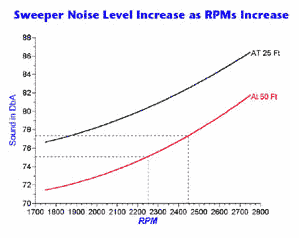Preventive Maintenance for Sweepers |

Raising Sweeper Performance Lowers Noise Outputby Leon DrakeRoutine maintenance is extremely important with regard to your air sweeper's noise and performance levels. If you don't maintain the system, your sweeper will soon wind up with a decrease in pickup efficiency. That also translates into an increase in noise output, since you'll have to increase your fan speed in order to get the same level of pickup efficiency. This, in turn, increases your rpms, and increasing them requires substantially more horsepower. That means you're making more noise, burning more fuel and putting more wear on your engine. And, the loss in performance forces you to increase your sweeping time, because your sweepers can't pick up material the way they're supposed to. In air systems, small leaks can develop in many places. Primary spots are around your sweeping head flap seals, on any hopper access doors and worn pipes and hoses. What many owners don't realize is that these leaks translate into a huge drop in performance. Exactly how much performance is lost due to any such air leaks? More than enough to make a big difference in your operation. That 'little' leak on the hopper may not amount to much in terms of pressure, but in terms of flow it adds up to quite a lot. For example, if you're not closing your hopper doors properly, or there's dirt on the seals, you can lose 500 cubic feet per minute (CFM) on each door. A 1,000 CFM loss may not sound like much, but most air sweepers are normally going to be pulling no more than about 7,000 CFM through the entire system while sweeping. At that rate, you'd be losing 1/7th of your air flow. Just a 1/8th inch of gap across the width of the sweeping head will cause a substantial loss of suction. A leak in the vacuum side of the system that measures 1/4 inch by 13 inches will consume about 500 CFM. If the system is running at 6000 CFM, the approximate operating rpm of a Schwarze S348-I, then the loss will require speeding the fan up from 2250 to 2450 RPM. This will increase the horsepower draw by 29%. The noise at 50 feet will increase from 75.1 dBA to 77.4 dBA. That's an increase of 2.3 dBA or 70% more noise. You can see why it's so important to maintain the system and the seals. 
Keep in mind that when you have a pressure loss, you're actually looking at what happens to your CFM. The CFM is what actually does the work - what carries the debris material into the hopper. As you lose pressure, you quickly lose CFM out of the system in terms of 'work' done by your pickup head. If you have a 14% loss of CFM, it means you have to speed up the sweeper engine by 14% to get the same workload accomplished. The equation for calculating the horsepower increase is: New horsepower equals old horsepower times (new rpm/old rpm)3. In this instance, that computes to an increase in horsepower of 48%. Suddenly, you're using 1.48 times the horsepower that it should take to do the job. 'Just' a 14% leak requires almost half again the horsepower! I think that puts the concept of 'little' leaks into a better perspective. Also, be sure not to confuse the concept of CFM with that of the fan curve, a mistake people often make. Because of the fan CFM that's listed on specification sheets, they think, "My fan can do this many CFM at this pressure at this rpm." Well, the fan can probably do the listed CFM, but it almost certainly won't be doing the rated CFM in the sweeper while it's in operation, or at the rated inches of pressure. The quoted CFM is typically a CFM at zero pressure with a wide-open engine. Often, people will quote the rated CFM (usually well over 10,000) and then, in the same breath, step back to the other end of the curve and say, "Yeah, and it's also doing 22 inches of pressure." Well, the 22 inches is at 500 CFM. You can't quote both pieces of information at the same time because, in reality, you're on opposite ends of the curve. That's a way people often get fooled when it comes to understanding sweeper performance. This is also a reinforcement as to why increasing the speed is going to eat you up in terms of fuel economy, reduced performance and increased noise levels. Air systems are very turbulent inside, which makes it hard to obtain accurate airflow profiles. You may have heard about the SAE standard for fan testing. For the SAE test, they disconnect the pickup head from the system and use just the duct pointed straight at the ground. That gives you a smooth intake but, although you're measuring what can go up in the hopper, it's not a realistic measurement. That's because the SAE text excludes all the restrictions in the sweeping head, and those are what reduce the ability of a particular sweeper design to pick up material during actual operation. Half of the system is eliminated prior to taking the measurement. As a result, the SAE test results can be a poor reflection of how a given sweeper actually performs in the field. Yes, you get a smoother profile to measure in the duct, but it's far from realistic. By disconnecting that part of the system, you're going to get a great deal more CFM, because the restrictions that are inherent in what might be correctly termed the 'heart' of the sweeping system are gone. Personally, I would like to see a measurement that is more of a true reflection of actual sweeping ability. It would be a more realistic example of what a given sweeper model can do in the field. To me, that's more important than any kind of 'bench test' CFM rating can ever reflect. When he wrote this, Leon Drake was a member of the Schwarze Industries engineering team. This article is reprinted from American Sweeper magazine, Volume 7 Number 1, 1999. |
© 2005 - 2019 World Sweeper
|
Back to Preventive Maintenance Table of ContentsSite Map / Table of Contents |